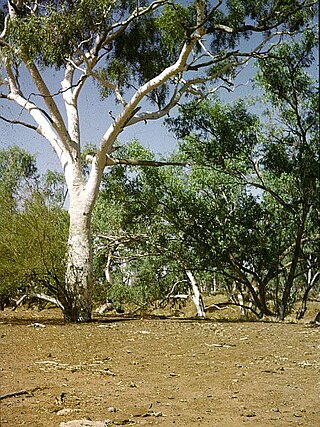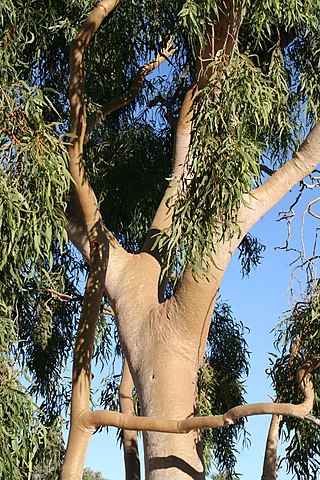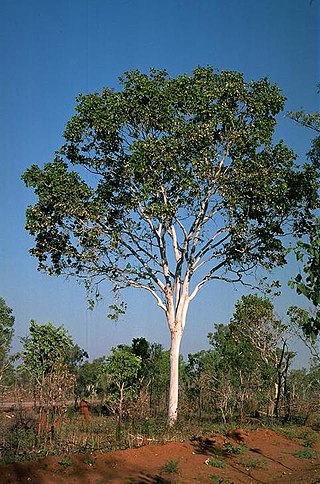
Corymbia papuana, commonly known as ghost gum, is a species of evergreen tree native to New Guinea, some Torres Strait Islands and the northern part of the Cape York Peninsula in Australia. It has smooth whitish bark, lance-shaped adult leaves, flower buds in groups of three or seven, creamy white flowers and barrel-shaped or urn-shaped fruit.
Corymbia greeniana is a species of tree that is endemic to northern Australia. It has rough bark on some or all of the trunk and larger branches, smooth bark above, broadly lance-shaped to egg-shaped adult leaves, flower buds usually in groups of seven, creamy white flowers and urn-shaped fruit with a distinct neck.

Corymbia flavescens, commonly known as cabbage ghost gum, bastard ghost gum, scraggy cabbage gum, or wrinkle-leaf ghost gum, is a species of tree that is endemic to northern Australia. It has smooth powdery bark, egg-shaped to lance-shaped adult leaves, flower buds in groups of three, white flowers and variably-shaped fruit. The Jaru peoples know it as warlarri.

Corymbia zygophylla, commonly known as the Broome bloodwood, is a species of small tree or a mallee that is endemic to Western Australia. It has rough, tessellated to fibrous bark on the trunk and branches, a crown of juvenile heart-shaped to lance-shaped, stem-clasping leaves, flower buds in groups of three or seven, white flowers and urn-shaped to shortened spherical fruit.

Corymbia aspera, commonly known as rough-leaved ghost gum, rough leaf range gum, desert bloodwood, Brittle Range gum in Western Australia, or snappy gum in the Northern Territory is a species of tree that is endemic to northern Australia. It has smooth white bark, sometimes with a short stocking of rough bark near the base, a crown of sessile juvenile, heart-shaped or egg-shaped leaves, flower buds in groups of seven, creamy white flowers and cup-shaped, barrel-shaped or cylindrical fruit.

Corymbia bella, commonly known as ghost gum, weeping ghost gum, or paper-fruited bloodwood, is a species of tree that is endemic to northern Australia. It has smooth, powdery, white to pale grey bark, lance-shaped adult leaves, flower buds in groups of three, creamy white flowers and cup-shaped, barrel-shaped or urn-shaped fruit.

Corymbia blakei, commonly known as ghost gum, is a species of tree that is endemic to Queensland. It has smooth bark, sometimes with a stocking of rough bark on older specimens, linear to narrow lance-shaped adult leaves, flower buds usually in groups of three, creamy white flowers and barrel-shaped, cup-shaped or cylindrical fruit.

Corymbia clavigera, commonly known as apple gum or cabbage gum, is a species of tree that is endemic to a small area in the north-west Kimberley region of Western Australia. It has smooth, pale grey and white bark, lance-shaped or elliptical adult leaves, flower buds in groups of three or seven, white flowers and urn-shaped to barrel-shaped fruit.

Corymbia cliftoniana is a species of tree that is endemic to northern Australia. It has thick, rough, tessellated bark on the trunk and branches, narrow lance-shaped adult leaves, flower buds in groups of seven, creamy white flowers and shortened spherical fruit.

Corymbia confertiflora, commonly known as broad-leaved carbeen or rough leaf cabbage gum, is a species of tree that is endemic to northern Australia. It has rough, tessellated bark near the base of the trunk, smooth white to pale grey bark above, a crown of both intermediate and adult leaves, large numbers of flower buds borne on leafless sections of branchlets in groups of seven, creamy white flowers and cylindrical to barrel-shaped or bell-shaped fruit.
Corymbia dendromerinx, commonly known as ghost gum, is a species of tree that is endemic to the south-western Kimberley region of Western Australia. It has smooth bark, sometimes with a stocking of rough bark near the base, a crown of variably-shaped leaves, flower buds mostly in groups of seven, creamy white flowers and barrel-shaped, cylindrical or cup-shaped fruit.

Corymbia dichromophloia, commonly known as small-fruited bloodwood, variably-barked bloodwood or gum-topped bloodwood, is a species of tree that is endemic to northern Australia. It has smooth white bark sometimes with flaky bark on the trunk, lance-shaped adult leaves, flower buds usually in groups of seven, creamy white flowers and urn-shaped fruit.

Corymbia erythrophloia, commonly known as red bloodwood, variable-barked bloodwood, red-barked bloodwood or gum-topped bloodwood, is a species of tree that is endemic to Queensland. It has rough bark on the trunk and branches, egg-shaped or lance-shaped adult leaves, flower buds in groups of seven, creamy white flowers and urn-shaped to spherical fruit.

Corymbia ferriticola, commonly known as Pilbara ghost gum, is a species of tree or a mallee that is endemic to Western Australia. It has smooth bark, lance-shaped adult leaves, flower buds in groups of seven, creamy white flowers and shortened spherical to cylindrical fruit.

Corymbia foelscheana, commonly known as broad-leaved bloodwood, fan-leaved bloodwood or smooth-barked bloodwood, is a species of small tree that is endemic to northern Australia. It has thin, rough, tessellated bark on some or all of the trunk, smooth bark above, broadly egg-shaped to broadly lance- shaped adult leaves, flower buds usually in groups of seven, creamy white flowers and urn-shaped fruit.

Corymbia gilbertensis, commonly known as Gilbert River ghost gum or Gilbert River box, is a species of tree that is endemic to tropical far north Queensland. It has rough, tessellated bark on the lower part of the trunk, smooth bark above, a crown of juvenile, intermediate and adult leaves, flower buds mostly in groups of seven, creamy white flowers and cup-shaped to barrel-shaped fruit.

Corymbia grandifolia, commonly known as cabbage gum, large-leaved cabbage gum and paper-fruited bloodwood, is a species of tree that is endemic to northern Australia. It has smooth bark, egg-shaped to broadly elliptic to lance-shaped adult leaves, flowers buds in groups of three or seven, creamy white flowers and cup-shaped to cylindrical fruit.
Corymbia hamersleyana is a species of small tree or mallee that is endemic to the Pilbara region of Western Australia. It has rough, flaky bark on part or all of the trunk, smooth cream-coloured bark above, lance-shaped adult leaves, flowers buds in groups of seven or nine, creamy white flowers and urn-shaped fruit.

Corymbia latifolia, commonly known as round-leaved bloodwood, round leaf bloodwood, wubam and other names in indigenous languages, is a species of tree that is endemic to northern Australia. It has thin, rough bark over part or all of the trunk, smooth bark above, triangular or broadly egg-shaped adult leaves, flower buds in groups of seven, creamy white flowers and urn-shaped fruit.
Corymbia torta is a species of tree that is endemic to the Kimberley region of Western Australia. It has smooth bark, lance-shaped adult leaves, flower buds in groups of three or seven, creamy white flowers and cup-shaped, cylindrical or barrel-shaped fruit.
















